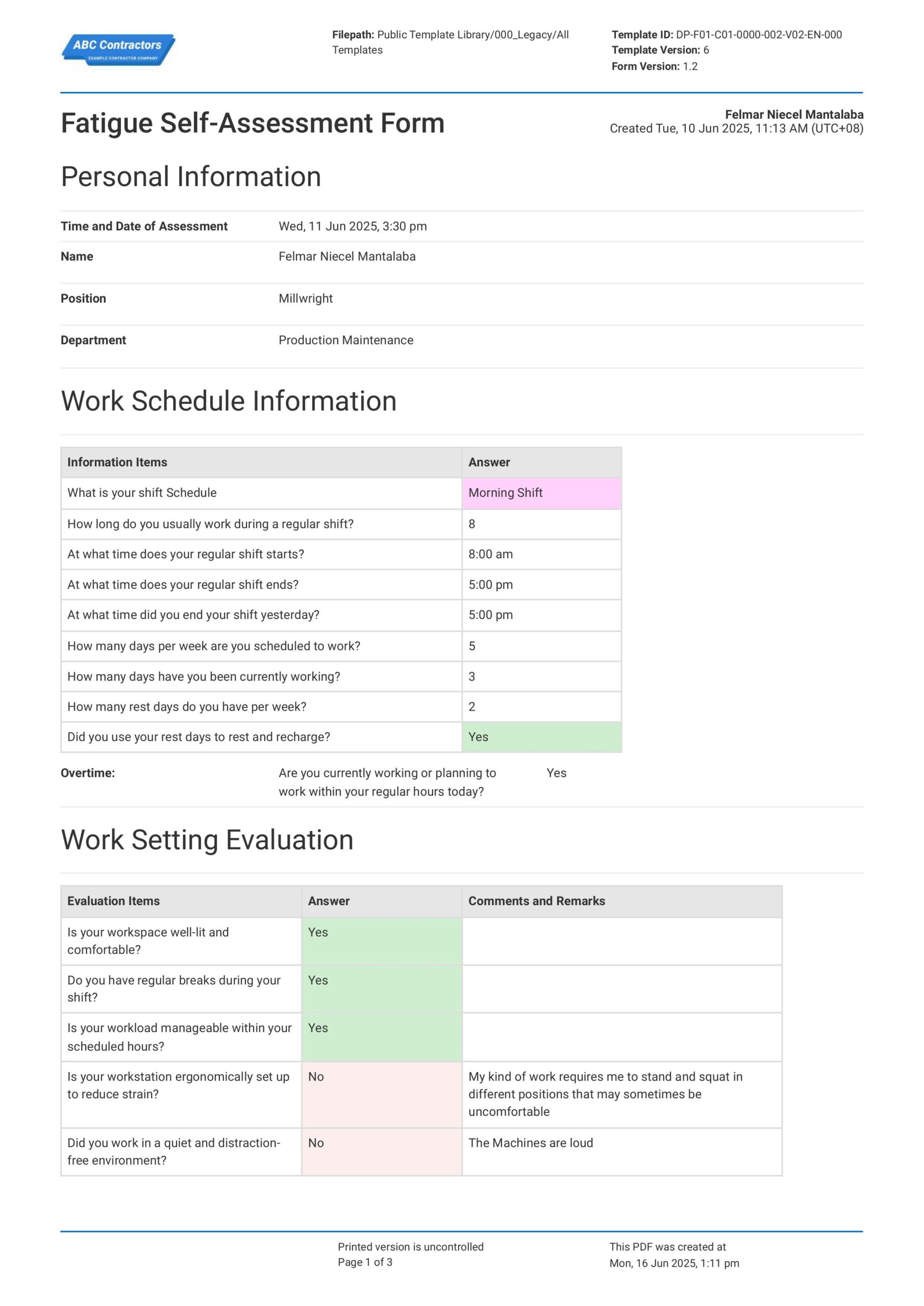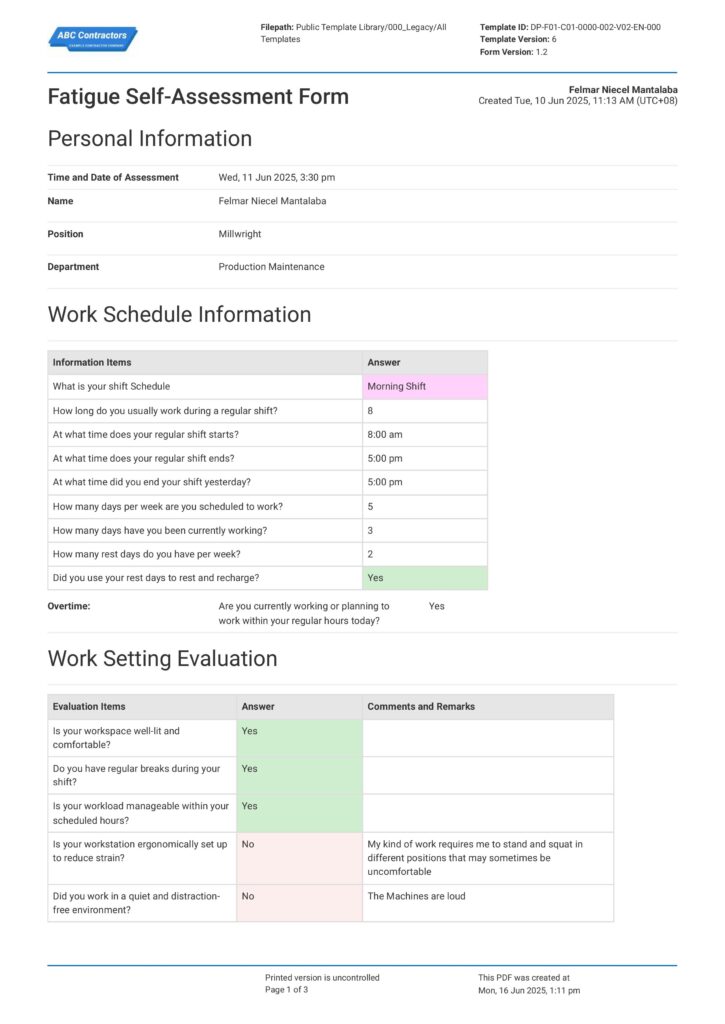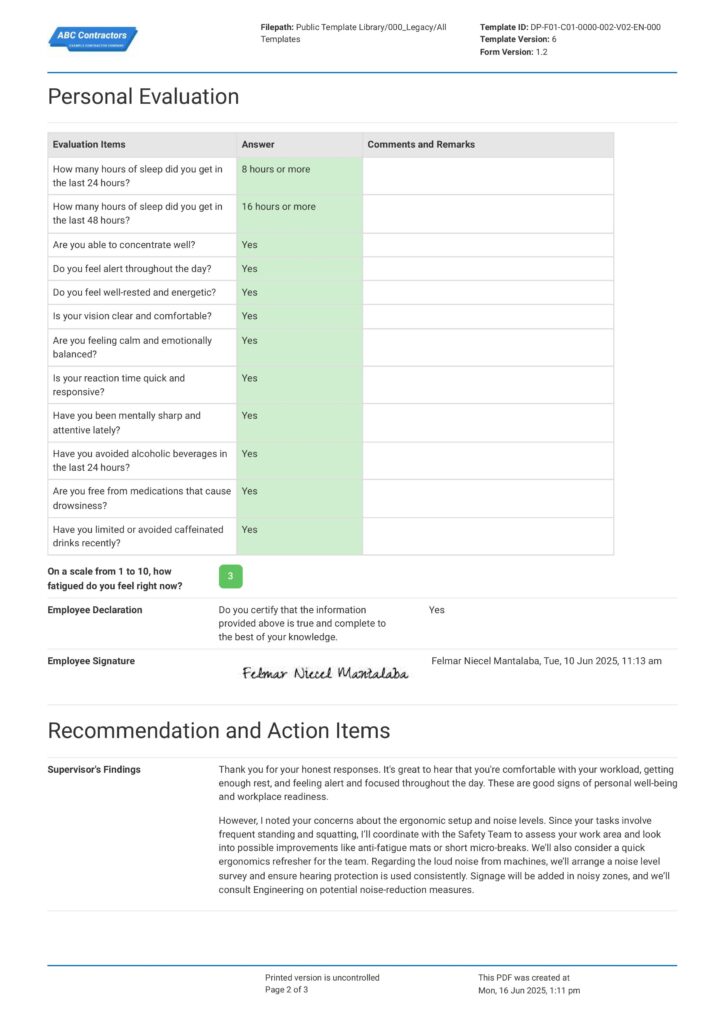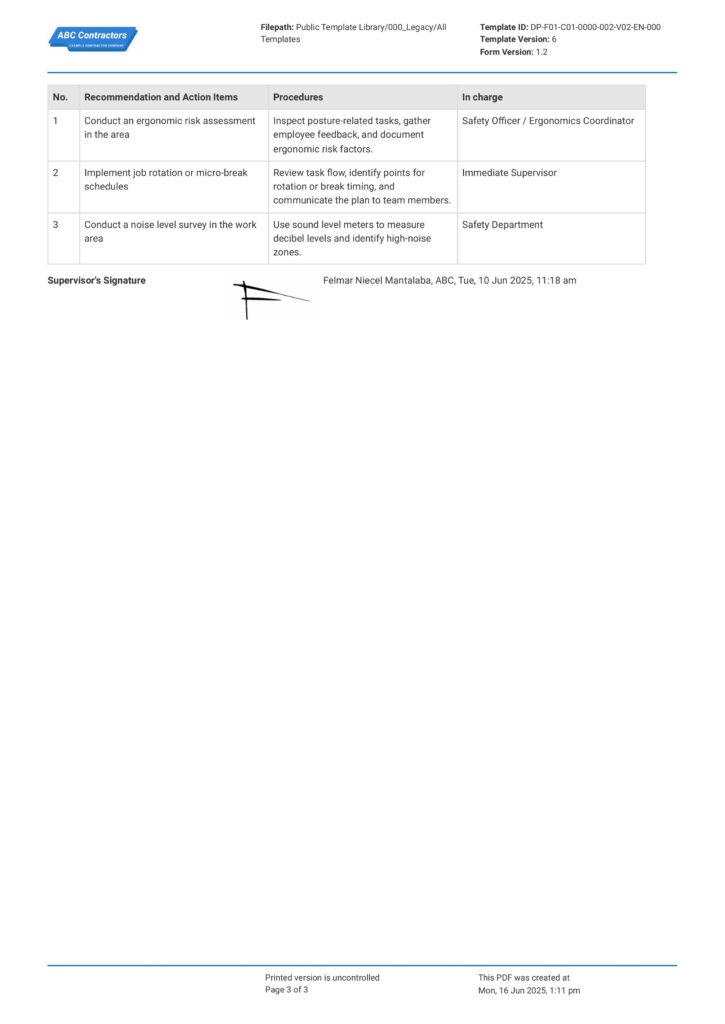Fatigue Self-Assessment Form Template
Start with a free 30-day trial. No credit card required.

~10,000 employees
~500 employees
~25,000 employees
~20 employees
~50 employees
~1,500 employees
~20 employees
What is a Fatigue Self-Assessment Form?
A Fatigue Self-Assessment Form is a questionnaire that helps assess a worker's degree of exhaustion and how it can affect their day-to-day work activities. Workers may learn more about their energy levels, sleep habits, and general physical and mental health through this evaluation. This self-assessment can also assist in determining the root causes of fatigue and help supervisors make the required work arrangement changes or seek the right kind of medical assistance. The Fatigue Self-Assessment Form helps workers to take proactive measures to improve their well-being and enhance their work quality by identifying the root cause of fatigue.
Compare this Fatigue Self-Assessment Form to paper-based forms created from Word, Excel, or PDF
Use this Fatigue Self-Assessment Form template for free.
The impacts of fatigue
Fatigue in the workplace is often overlooked because many workers don't know that they are experiencing it. Yet its impact can be just as serious as physical injuries—sometimes even worse. Understanding how fatigue affects the body and mind stresses the importance of the need to address this hazard. Here are the prominent effects of fatigue:
More than just feeling tired
Fatigue can manifest into various symptoms. Slow reaction time, poor decision-making, and mental fog are a few examples of how fatigue develops in a person. Workers often overlook these symptoms or remain complacent about them, which increases the risk of fatigue-related hazards. Conducting fatigue assessments can help workers become aware of these symptoms and more vigilant of their health.
Consequences build up
Timely intervention can manage early signs of fatigue. However, if left unchecked for far too long, it can develop into much more chronic physical and mental health problems. Conducting fatigue assessments can help eliminate the possibility of fatigue escalating toward these levels.
Affects quality outputs
Business outputs also suffer from the effects of fatigue. Fatigued workers are more likely to make mistakes, misjudge situations, or skip steps—all of which affect the quality of work. This results in increased instances of poor equipment handling, the need for reworks, and extended deadlines, which in turn raises costs, decreases reliability, and harms productivity.
Reducing fatigue-related incidents through early detection
Visual cues or a supervisor’s gut feeling are not enough to determine if a worker is fatigued. By the time fatigue becomes visible, workers may have already compromised their safety. Regular and constant fatigue assessments allow companies to catch the signs of fatigue at their earliest and provide immediate solutions. To provide more clarity, here is an explanation of how this simple questionnaire can guide the intervention of fatigue.
Fatigue develops gradually
Fatigue doesn’t appear suddenly—it builds up over time due to habits and working conditions that contribute to it. Workers may experience tiredness at first, which may seem harmless. However, without the correct intervention, the symptoms can evolve into much more serious conditions that affect the workers' health and the quality of their work.
Helpful data for a healthier workplace
Completing the Fatigue Self-Assessment form and receiving a recommendation is only one part of the overall assessment process. Compiling all of these assessments provides valuable data for companies. Identifying repeated patterns in the answers can help companies determine root causes, allowing them to implement accurate measures that eliminate fatigue-related hazards and maintain a healthy, safe workplace.
Prevention is better than reaction
It is always better to take a proactive approach in eliminating fatigue in the workplace. Catching early signs of fatigue allows companies to intervene before it compromises health, safety, and productivity. The goal is to stop fatigue from escalating, whether this is achieved by reassigning tasks, encouraging breaks, or even sending someone home to rest. Using prevention lessens incident rates and builds a safety-first culture where employees feel supported and heard.
Awareness on fatigue through a fatigue questionnaire
Fatigue Self-Assessment Forms are not just for collecting data. These questionnaires help employees become more aware of their physical and mental health and empower them to take action before their conditions start to drastically deteriorate because of fatigue. When workers are more aware of their sleep hours, work ability, and warning signs of poor health, it promotes introspection and ownership of their well-being.
Such awareness is especially important in high-risk industries—like mining and construction. These industries require employees to maintain optimal health and well-being, as even a single mistake can lead to serious consequences. Regular and constant assessments can help bring a new normal to fighting fatigue. Employees can voice their concerns without fear of censure and build a proactive practice to stop fatigue. Establishing this practice helps ensure that the workplace is not only safe but also supportive—a safe space where workers are supported and seen.
Frequently Asked Questions
Why use this Fatigue Self Assessment Form?
Sitemate's Fatigue Self-Assessment Form serves as an effective tool for fatigue monitoring, trusted by thousands of companies across the construction, mining, and industrial sectors. It is pre-configured to align with fatigue risk management best practices and is designed for ease of use, making it suitable for workers at all levels and across various job functions.
Is this template compliant with ISO 45001 standards?
Yes – this template can be configured to align with ISO 45001 requirements as well as local safety legislation in Australia, the UK, New Zealand, and other regions. It is already in use by certified contractors across various industries to support both the attainment and maintenance of certification status.
Can I edit this Fatigue Self-Asssessment Form for my project or company?
Yes – this template is fully adjustable through a user-friendly drag-and-drop interface. It supports a wide range of field types such as tables, formulas, sketches, photos, and more, allowing flexible data capture for various use cases. Users can also personalize the layout by adding their company logo, custom headers, and other structural elements. All configurations are enabled through Dashpivot’s built-in template builder.
What formats is this form available in?
This template is compatible with all devices—including computers, mobile phones, and tablets—allowing users to edit and complete forms from any location, including directly in the field. Once filled out, records can be generated or exported as PDF or CSV files, combining the familiar benefits of Word, PDF, and Excel formats with the efficiency of modern software.
Other popular templates you can use and edit for free

Fatigue Risk Calculator
Assess employee fatigue levels before it becomes a serious hazard in the workplace.

Fatigue Management Checklist
Easily document and manage workplace fatigue by using a fatigue checklist report.

Health and Safety Risk Register
Stay on top of the hazards in the workplace and seamlessly identify, assess, and control risks to reduce incidents.
This form was generated with Dashpivot.
Catch fatigue before it catches danger. This Fatigue Self-Assessment Form is the smart solution to provide quick fatigue assessments, making your workplace always safe and healthy.
- Complete, edit, and review the Fatigue Self-Assessment Form from any device.
- Export and send results as perfectly formatted PDF documents with your company logo.
- Securely store and manage your results online for easy searching and finding.
- Immediately notify relevant personnel after filling out the assessment form.
Sitemate builds best-in-class software tools for built world companies.


